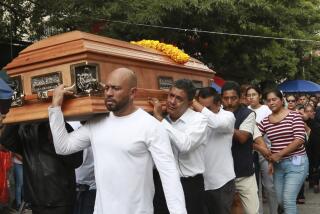Marcos De-Emphasizing Prestige Arms : Seeking More Basic U.S. Weapons to Fight Communist Rebels
- Share via
WASHINGTON — The Philippine government, responding to advice from the United States, has revised its military shopping list to emphasize rifles, bullets and other mundane equipment needed to combat an increasingly potent Communist insurgency, instead of high-prestige items like jet aircraft, U.S. officials said Saturday.
After several years of attempting to minimize the threat posed by the New People’s Army, the government of President Ferdinand E. Marcos has agreed to restructure its military programs to give top priority to defeating the guerrillas, the officials said.
In response, the Reagan Administration plans to revise its aid program for the Philippines to concentrate on infantry and counterinsurgency weapons without increasing the overall amount, which was set at $900 million over five years as part of the agreement signed last year to renew the U.S. leases on Clark Air Base and Subic Bay Naval Base.
“The stuff they need is very basic,” a State Department official said. “They have soldiers out in the boondocks without uniforms and who can’t communicate with their posts. They need training in order to know how to behave properly with the civilian population. It is that sort of thing that is under discussion.”
Boots and C Rations A Pentagon official added, “Look how many boxes of ammunition and pairs of boots and C rations you can buy with (the cost of) one missile.”
In previous years, the Marcos government had sought to build military prestige with high-performance weapons like F-16 jet warplanes and Harpoon ship-to-ship missiles.
The new Washington-Manila strategy was worked out earlier this month during separate--but clearly coordinated--visits to the Philippines by Assistant Secretary of State Paul D. Wolfowitz and Assistant Defense Secretary Richard L. Armitage. Both men are on extended tours of the Asia-Pacific region.
According to State Department and Pentagon officials, both Wolfowitz and Armitage urged the Philippine authorites to improve training and discipline of the troops to avoid antagonizing the civilian population.
“Armitage concentrated on improvement to the armed forces,” the Pentagon official said. “He said we want to see improvement in the civil behavior of the armed forces because you cannot bring the civilian population over to your side if you have abuses in the army.”
The official charged that the Communists have murdered town mayors and committed other outrages. However, he said, the government must ensure that its own troops do not commit atrocities if it hopes to capitalize on the misdeeds of the New People’s Army.
Minimizing the Threat Marcos cited the Communist insurgency in 1972 when he declared martial law. When he lifted the martial-law decree in 1981, he declared that the guerrillas had been defeated. Since then, he has sought to minimize the Communist threat.
“We have had a perception that the government has been slow to recognize the seriousness of the insurgency, partly because that was the way they saw it and partly for reasons of policy,” a State Department official said. “People who are close to the top now realize that this may be more serious than they had thought.”
The New People’s Army has an estimated 10,000 to 11,000 troops. It is the only armed challenge to the Marcos government, although there has for more than a decade been a substantial non-Communist political opposition, much of it now centered on the political heirs of Benigno S. Aquino Jr., murdered in 1983 when he returned to Manila from exile in the United States.
Aquino was popular in the U.S. Congress, a situation that makes it more difficult for the Administration to win approval of military aid to the Marcos government.
Under the agreement for continued U.S. use of the air and naval bases in the Philippines, the United States is to provide about $180 million a year in combined economic assistance, military grants and military credit sales for the next five years.
The Pentagon official said the Administration hopes to increase the share of military grants, while reducing economic aid and avoiding loans that would add to Manila’s already heavy debt burden.
Last year, Congress took the opposite tack, increasing the proportion of economic aid to the Philippines at the expense of the military categories.
More to Read
Sign up for Essential California
The most important California stories and recommendations in your inbox every morning.
You may occasionally receive promotional content from the Los Angeles Times.













